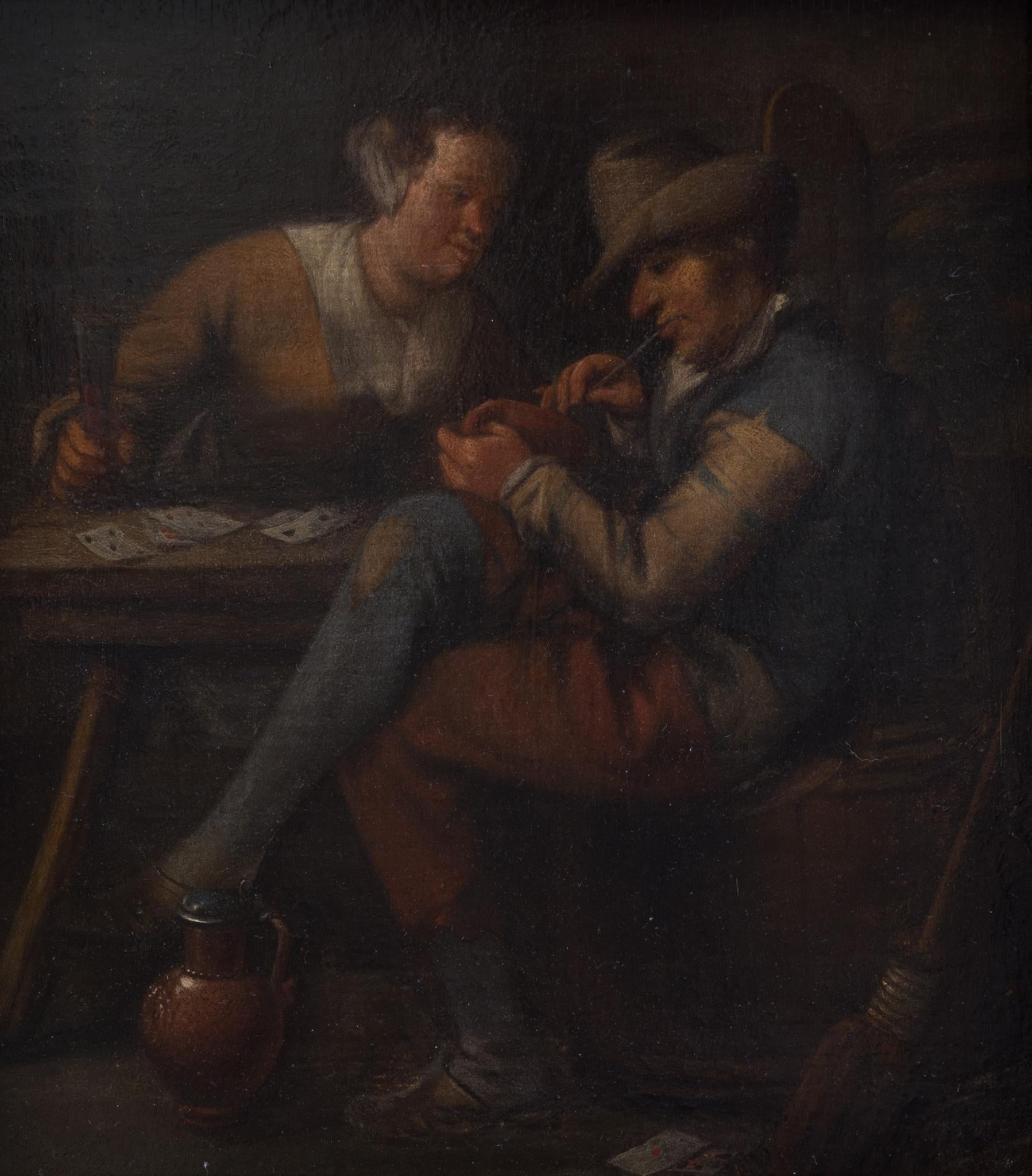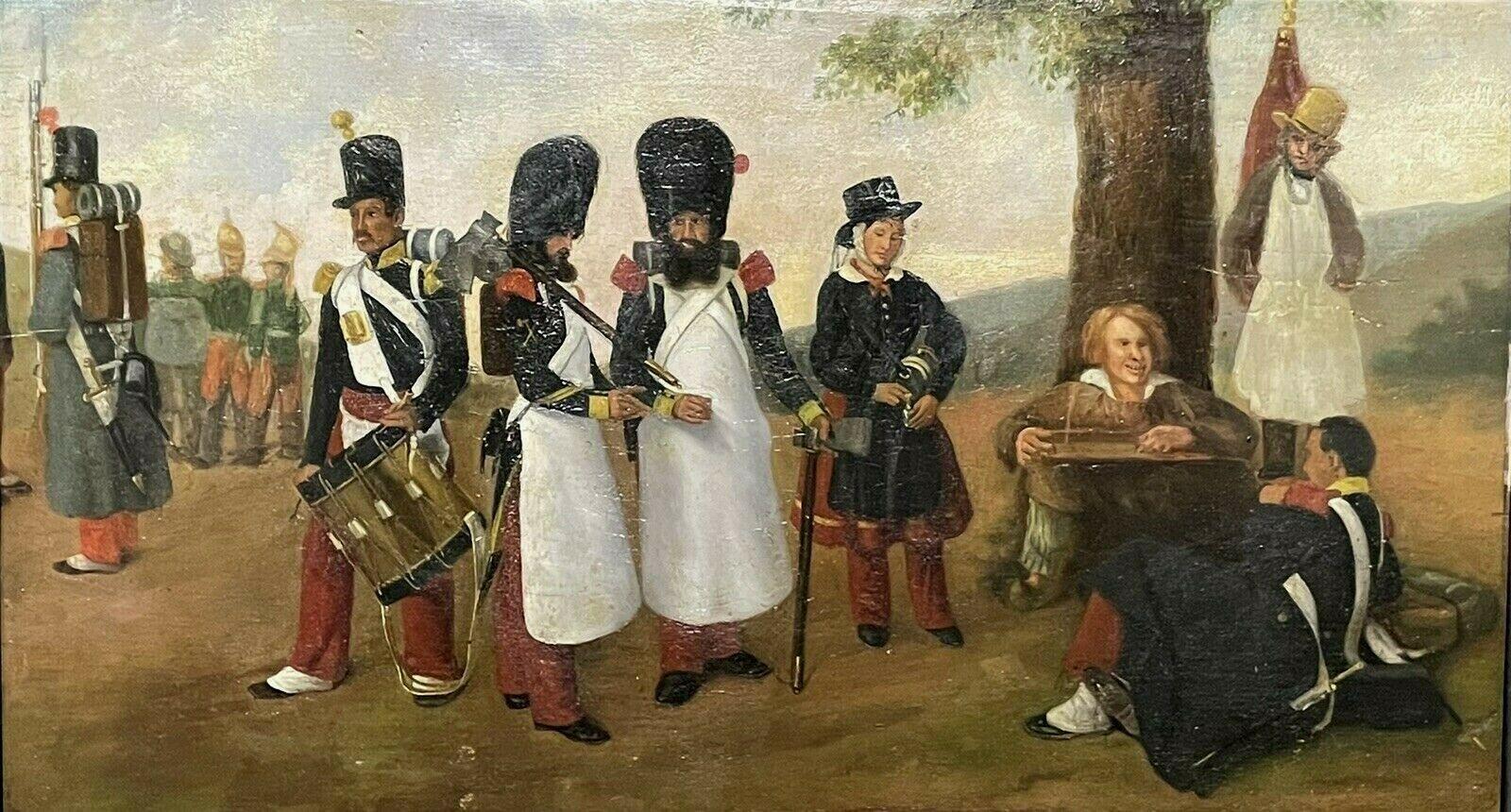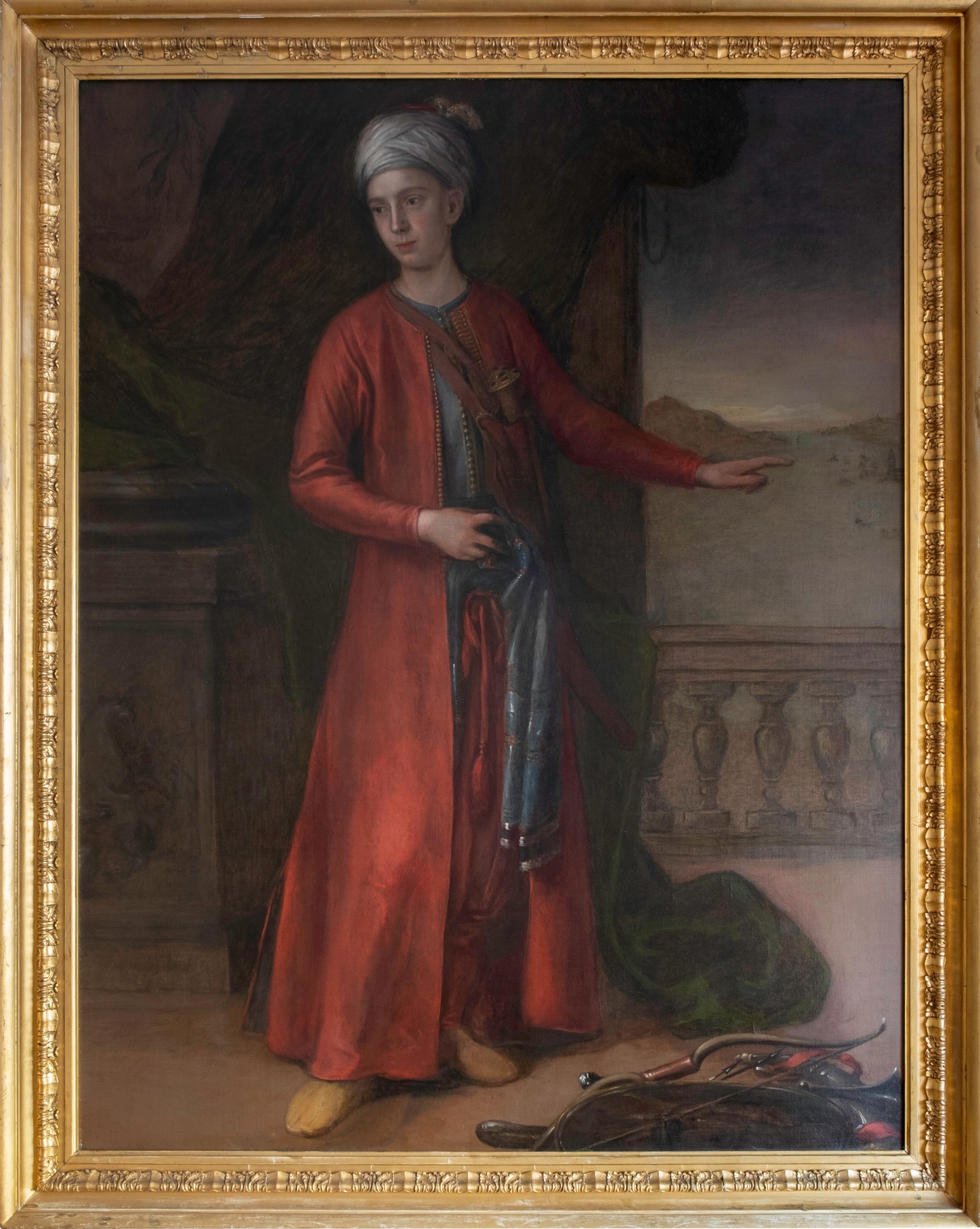Items Similar to 17th century German portrait of a man - Wine merchant Caspar Roemerskirchen 1628
Want more images or videos?
Request additional images or videos from the seller
1 of 14
17th century German portrait of a man - Wine merchant Caspar Roemerskirchen 16281628
1628
About the Item
17th century German portrait of the wine merchant Caspar Roemerskirchen at the age of 26 in 1628, attributed to Gottfried de Wedig
This highly decorative portrait depicts the 26 year old Caspar Roemerskirchen, wearing an intricate jacket made of a luxurious black fabric, which is stiffened and shaped to perfectly fit his silhouette. It is adorned with an opulent collar, which at the time was a true status symbol, worn to emphasise the refined class and social status of the sitter. In his hands he is holding luxurious soft leather gloves. The vivid green drapery and table cloth add further vivacity to the portrait. His ice blue eyes appear to be shimmering with a life-like quality.
Gottfried de Wedig (also known as Gotthardt) was a German painter born in 1583 in Cologne. His grandfather was the celebrated artist Barthel Bruyn the Younger, who probably taught him to paint. Gottfried is particularly remembered for portraits and still-lifes. De Wedig's portraits of the upper class in Cologne offer valuable glimpses into the social fabric and cultural ambiance of the period. By immortalizing notable figures, De Wedig not only preserved their identities but also recorded the prevailing power dynamics and societal norms. In addition to their aesthetic value, his portraits also serve as historical artifacts, providing insights into the fashion, lifestyle, and aspirations of his sitters. Beyond their documentary value, Wedig's legacy resonates through his artistic mastery and his ability to capture emotion endow his portraits with a timeless allure. The paintings transcend mere representation; they serve as windows to a bygone era, offering enduring reflections on the human condition and the transformative power of art across time.
His works have been included in notable museums and collections including in: Louvre (Paris), Wallraf-Richartz-Museum (Cologne) and the Kölnisches Stadtmuseum (Cologne).
Measurements: The board measures ca. 97 by 75 cms and with frame ca. 115 by 93 cms.
Provenance: Private collection Germany (as Franz Kessler)
Selected literature on the artist:
H. Vey, 'Nochmals Gottfried von Wedig, Auguste Braun und Everhard Jabach', Wallraf-Richartz-Jahrbuch 35 (1973), p. 261-280
H. Vey, 'Gottfried von Wedig', Wallraf-Richartz-Jahrbuch 24 (1962), p. 295-320
M. Spies, 'Neue Erkenntnisse zu Gottfried von Wedigs Bildnis der Magdalena Stroe (1631)', Wallraf-Richartz-Jahrbuch 70 (2009), p. 305-308
H. Vey, 'Neues zu Augustin Braun und einige Kölner Zeitgenossen', Wallraf-Richartz-Jahrbuch 51 (1990), p. 295-320
- Attributed to:Gottfried De Wedig (1583 - 1641, German)
- Creation Year:1628
- Dimensions:Height: 37.8 in (96 cm)Width: 29.53 in (75 cm)
- Medium:
- Movement & Style:
- Period:
- Condition:Lovely and ready to hang. Cleaned in 2024, some scattered inpainting visible under uv-light. Light age-related wear to the frame.
- Gallery Location:Antwerp, BE
- Reference Number:1stDibs: LU1423213917832
About the Seller
5.0
Platinum Seller
These expertly vetted sellers are 1stDibs' most experienced sellers and are rated highest by our customers.
Established in 2020
1stDibs seller since 2020
348 sales on 1stDibs
Typical response time: 1 hour
- ShippingRetrieving quote...Ships From: Antwerp, Belgium
- Return PolicyA return for this item may be initiated within 2 days of delivery.
More From This SellerView All
- 17th century Flemish Old Master - A young boy enjoying a pie, allegory of tasteLocated in Antwerp, BE17th century Flemish old master painting, Allegory of taste The very fine painting depicts a young boy, cheekily tasting a delicious pie. He's looking at the viewer with eyes twinkl...Category
17th Century Old Masters Figurative Paintings
MaterialsCanvas, Oil
- 17th century old master portrait of Emperor Rudolph IILocated in Antwerp, BE"Portrait of Emperor Rudolph of Austria (1557-1619)" circle or studio of Josef Heinz the Elder Emperor Rudolph II, born in 1552, was a visionary ruler whose reign as the Holy Roman ...Category
17th Century Old Masters Portrait Paintings
MaterialsCanvas, Oil
- 18th century Portrait of a lady as Erato, the muse of poetry - Angelica KauffmanBy Angelica KauffmannLocated in Antwerp, BE18th century English school portrait of a lady, said to be Mrs. John Ruscombe of Colne, Lancaster, as the muse Erato This very skilfully painted portrait depicts a lady as the muse Erato, playing the Lyre. Her eyes are filled with emotion and her lips are curved in a soft, delightful smile. Hinting at the love song she is composing? Erato is one of the nine Muses in Greek mythology. She is the muse of lyric poetry, love poetry, and mimicry. Erato is often depicted holding a lyre, symbolizing her association with music and poetry. She inspires poets and writers to create works that celebrate love, beauty, and human emotions. Our painting was sold in the early 1900s as a work by Angelica Kauffman. Kauffman was an 18th-century Swiss Neoclassical painter who achieved significant success and recognition in a male-dominated art world. Born in Switzerland in 1741, she showed exceptional talent from a young age and received formal art training in Italy. Kauffman gained fame for her historical and mythological paintings, as well as her portraits, which were characterized by their grace, elegance, and classical influences. She was a founding member of the Royal Academy of Arts in London and enjoyed patronage from aristocrats and royalty throughout Europe. Kauffman's work contributed to the rise of Neoclassicism and she remains one of the most prominent female artists of her time. Measurements: Oil on canvas ca. 98 by 77cm and with the frame ca. 118 by 97 cm Provenance: Collection of Felix Gouled American Art Association, Anderson Galleries, by 1937 Kende Galleries at Gimbel Brothers, Jay Gould...Category
18th Century Old Masters Portrait Paintings
MaterialsCanvas, Oil
- 17th century Old Master Portrait of Queen Catherine of BraganzaBy Jacob HuysmansLocated in Antwerp, BEVery fine old master Portrait painting of Queen Catherine of Braganza as Saint Catherine attributed to Jacob Huysmans and studio Catherine of Braganza...Category
17th Century Old Masters Portrait Paintings
MaterialsOil, Canvas
- 17th century Old Master painting - Allegory of Justice - truth demons skeletonLocated in Antwerp, BELate 17th, early 18th century old master oil painting depicting an allegory of Lady Justice holding demons at bay Our painting, likely a sketch for a much larger work,, conveys a pr...Category
18th Century Old Masters Figurative Paintings
MaterialsCanvas, Oil
- Large 17th century Flemish old master painting - Diana and Callisto - RubensLocated in Antwerp, BE17th century Flemish Old master painting "Diana and Callisto" attributed to Victor Wolfvoet the Younger Our painting is based on Rubens' great work of...Category
17th Century Old Masters Figurative Paintings
MaterialsCopper
You May Also Like
- The Card Players by a Flemish 1600s ArtistBy Flemish School, 17th CenturyLocated in Stockholm, SEFlemish 1600s School The Card Players oil on oak panel panel dimensions 22.5 x 20 cm frame included Provenance: From a Swedish private collection. Condition: Flat and stabl...Category
17th Century Old Masters Figurative Paintings
MaterialsOak, Oil, Panel
- 19th CENTURY FRENCH ANTIQUE OIL ON PANEL - FRENCH SOLDIERS MAKING CAMPLocated in Cirencester, GloucestershireArtist/ School: French School, 19th century Title: The Soldiers Camp Medium: oil painting on thick wooden panel, with a bevel edge Size: painting: 12.5 x 22 inches, frame: 16.5 ...Category
19th Century Old Masters Figurative Paintings
MaterialsWood, Oil
- 17thC Spanish Colonial School Frame with orig. Painting St. Joseph Jesus ChildBy Spanish Colonial (Peruvian)Located in Meinisberg, CH17th Century Spanish Colonial School (Likely to be School of Cuzco in Peru) - St. Joseph with the Christ Child carrying a basket, housed in its original carved, hardwood frame. • Painted in oil on canvas (laid on to fiberboard), ca.58 x 48 cm • Original frame, ca. 64 x 54 cm • Visible image ca. 52.5 x 42.5 cm Centuries ago this religious painting, depicting St. Joseph with his flowering staff and the Christ Child carrying a basket, was originally displayed in a church or chapel in 17th Century colonial...Category
17th Century Old Masters Figurative Paintings
MaterialsGold Leaf
- 18th C. Portrait of the 4th Earl of Sandwich a View of Constantinople BeyondLocated in London, GBJohn Montagu, 4th Earl of Sandwich (13 November 1718 – 30 April 1792) Attributed to George Knapton (1698-1778) Dressed in the Turkish manner, stand...Category
18th Century Old Masters Figurative Paintings
MaterialsOil
- 18th Century Oil Painting Portrait of Provost John Pitcairn of DundeeBy Sir Henry RaeburnLocated in London, GBThe pendant to the present portrait showing John Pitcairn's wife Jean, née Robertson, is in the Huntington Art Gallery, San Marino. Both works are datable to the 1790s. Pitcairn, who served as Provost of Dundee from 1782-84, a position his father-in-law also held from 1731-32, later sat to Raeburn for another portrait, dated to circa 1820, which is now in the Royal Scottish Academy, Edinburgh Sale of Christie's London: Wednesday, July 9, 2014 [Lot 00212] Old Master & British Paintings Day Sale Sold For 22,500 GBP Premium Provenance By descent from the sitter to his great-grandson, Ronald Andrew Pitcairn of Pitcullo; Christie's, London, 25 June 1904, lot 58 (200 gns. to Wallis). Alexander Reid, Glasgow. With Agnew's, London, where acquired by A.R. Wilson Wood, 7 April 1909; Christie's, London, 26 June 1914, lot 78 (850 gns. to Agnew). Anonymous sale; Christie's, London, 24 November 1972, lot 27 (320 gns.) Private collection, Dublin, Ireland Exhibition Edinburgh, Royal Scottish Academy, 1876, no. 256 Literature W. Armstrong, Sir Henry Raeburn, London, 1901, p. 110. J. Greig, Sir Henry Raeburn, R.A., His life and work with a catalogue of his pictures, London, 1911, p. 55. R. Asleson and S.M. Bennett, British Paintings at The Huntington, New Haven and London, 2001, p. 312, fig. 12 Sir Henry Raeburn FRSE RA RSA (4 March 1756 – 8 July 1823) was a Scottish portrait painter and Scotland's first significant portrait painter since the Union to remain based in Scotland. He served as Portrait Painter to King George IV in Scotland. Raeburn was born the son of a manufacturer in Stockbridge, on the Water of Leith: a former village now within the city of Edinburgh. He had an older brother, born in 1744, called William Raeburn. His ancestors were believed to have been soldiers, and may have taken the name "Raeburn" from a hill farm in Annandale, held by Sir Walter Scott's family. Orphaned, he was supported by William and placed in Heriot's Hospital, where he received an education. At the age of fifteen he was apprenticed to the goldsmith James Gilliland of Edinburgh, and various pieces of jewellery, mourning rings and the like, adorned with minute drawings on ivory by his hand, still exist. Soon he took to the production of carefully finished portrait miniatures; meeting with success and patronage, he extended his practice to oil painting, at which he was self-taught. Gilliland watched the progress of his pupil with interest, and introduced him to David Martin, who had been the favourite assistant of Allan Ramsay the Latter, and was now the leading portrait painter in Edinburgh. Raeburn was especially aided by the loan of portraits to copy. Soon he had gained sufficient skill to make him decide to devote himself exclusively to painting. George Chalmers (1776; Dunfermline Town Hall) is his earliest known portrait. In his early twenties, Raeburn was asked to paint the portrait of a young lady he had noticed when he was sketching from nature in the fields. Ann was the daughter of Peter Edgar of Bridgelands, and widow of Count James Leslie of Deanhaugh. Fascinated by the handsome and intellectual young artist, she became his wife within a month, bringing him an ample fortune. The acquisition of wealth did not affect his enthusiasm or his industry, but spurred him on to acquire a thorough knowledge of his craft. It was usual for artists to visit Italy, and Raeburn set off with his wife. In London he was kindly received by Sir Joshua Reynolds, the president of the Royal Academy, who advised him on what to study in Rome, especially recommending the works of Michelangelo, and gave Raeburn letters of introduction for Italy. In Rome he met his fellow Scot Gavin Hamilton, Pompeo Girolamo Batoni and Byers, an antique dealer whose advice proved particularly useful, especially the recommendation that "he should never copy an object from memory, but, from the principal figure to the minutest accessory, have it placed before him." After two years of study in Italy he returned to Edinburgh in 1787, and began a successful career as a portrait painter. In that year he executed a seated portrait of the second Lord President Dundas. Examples of his earlier portraiture include a bust of Mrs Johnstone of Baldovie and a three-quarter-length of Dr James Hutton...Category
18th Century Old Masters Figurative Paintings
MaterialsOil
- Head of an AngelLocated in New York, NYProcaccini was born in Bologna, but his family moved to Milan when the artist was eleven years old. His artistic education was evidently familial— from his father Ercole and his elder brothers Camillo and Carlo Antonio, all painters—but his career began as a sculptor, and at an early age: his first known commission, a sculpted saint for the Duomo of Milan, came when he was only seventeen years old. Procaccini’s earliest documented painting, the Pietà for the Church of Santa Maria presso San Celso in Milan, was completed by 1604. By this time the artist had made the trip to Parma recorded by his biographers, where he studied Correggio, Mazzola Bedoli, and especially Parmigianino; reflections of their work are apparent throughout Procaccini's career. As Dr. Hugh Brigstocke has recently indicated, the present oil sketch is preparatory for the figure of the angel seen between the heads of the Virgin and St. Charles Borrommeo in Procaccini's altarpiece in the Church of Santa Afra in Brescia (ill. in Il Seicento Lombardo; Catalogo dei dipinti e delle sculture, exh. cat. Milan 1973, no. 98, pl. 113). As such it is the only known oil sketch of Procaccini's that can be directly connected with an extant altarpiece. The finished canvas, The Virgin and Child with Saints Charles Borrommeo and Latino with Angels, remains in the church for which it was painted; it is one of the most significant works of Procaccini's maturity and is generally dated after the artist's trip to Genoa in 1618. The Head of an Angel is an immediate study, no doubt taken from life, but one stylistically suffused with strong echoes of Correggio and Leonardo. Luigi Lanzi, writing of the completed altarpiece in 1796, specifically commented on Procaccini's indebtedness to Correggio (as well as the expressions of the angels) here: “Di Giulio Cesare...Category
17th Century Old Masters Figurative Paintings
MaterialsPaper, Canvas, Oil





